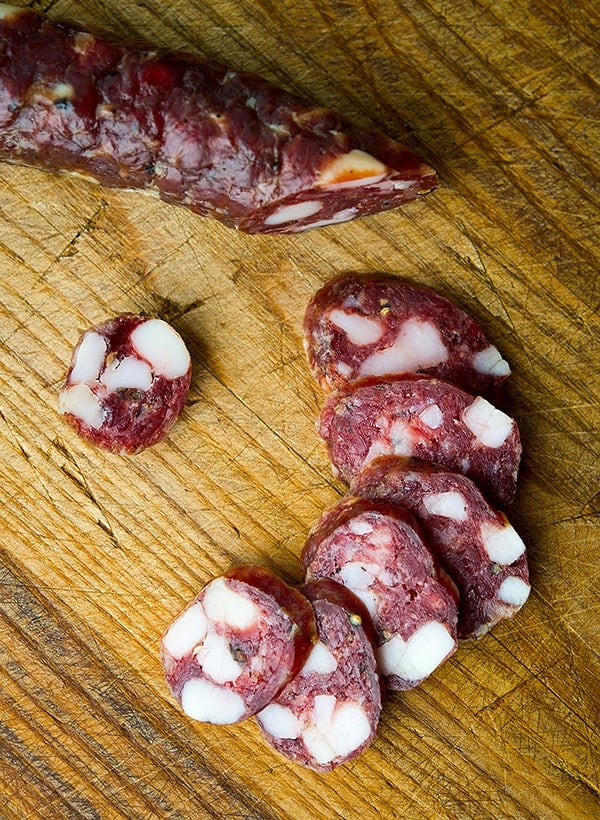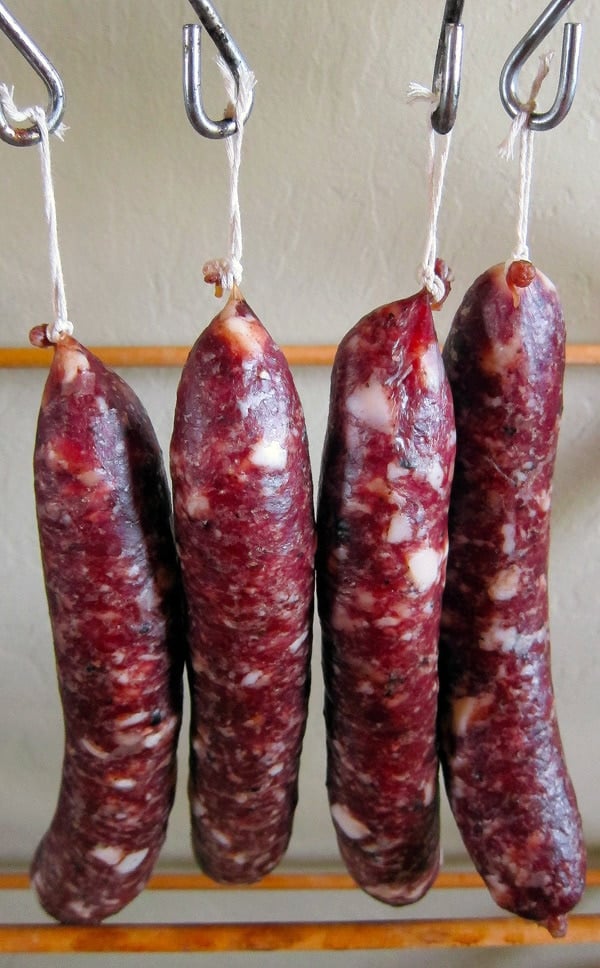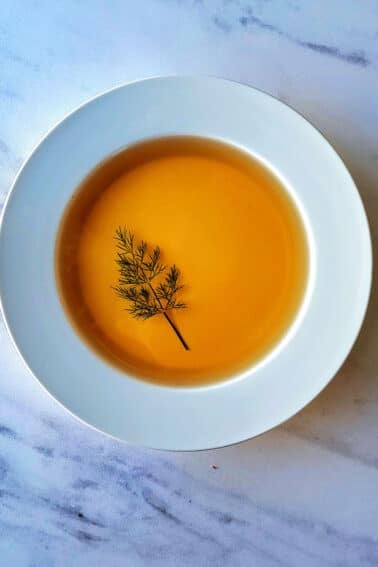As an Amazon Associate I earn from qualifying purchases.

With the possible exception of a whole dry-aged ham, to my mind salami is the highest form of the butcher’s art.
The careful crafting of raw meat, salt, spices and time create something very different from a fresh sausage. It is not crazy to call it alchemy. But making salami is no joke. It takes time, an attention to detail (and sanitation), plus a careful eye to troubleshoot problems. Doing this at home is not for beginners.
But when you do pluck up enough courage to make your own at home, this is the salami recipe you should start with. It is the classic, the “little black dress” of a salami, flavored only with salt, black pepper and a bit of garlic. The meat is the star here, not the spices.
Every salami-making culture makes a version of this sausage, and recipes are similar whether you look to Spain or France or Italy or Hungary or Germany — although these last two nations tend to smoke their salami, too.
If you’ve never made fresh sausages before, bookmark this recipe and come back when you’ve made a dozen or so batches. You need to be comfortable with the basic sausage-making process before you take the step of curing them. You also need some special equipment. Don’t try to shortcut salami making. You will pay for it eventually.
First, you need a good grinder. For small batches I use the KitchenAid grinder attachment, but with anything larger than 5 pounds, I use a Weston grinder. You need a sausage stuffer, too. Can you hand-cut the meat and fat? Yes, but it requires a sharp knife and an awful lot of patience.

To hang your sausages for the few days it takes to ferment them, I use a simple wooden clothes rack. I also buy “S” hooks from the local hardware store to hang the links. You’ll also need a humidifier both for the fermentation process and while your links are drying. I use this one , and it’s worked well for me for 3 years now.
Finally, you must have a curing chamber; my friends at Elevated Wild have a DIY tutorial here, and I use a fancy Dry Ager, which ain’t cheap, but it’s great.
The salami-making process is this: You make sausage, only with added sodium nitrate (Instacure No. 2) and a starter culture, then ferment the sausages at room temperature for a few days to let the good bacteria in the starter beat back any bad bugs within the meat. Do you need these? Absolutely.
Yeah, I hear you: “But can’t salami be made without them?” Yes. But you can’t. The people who can work in places where they’ve made salami for decades or even centuries, and the ambient air has the good bacteria already; it’s like a sourdough. For you and me, nitrate and starter culture is an insurance policy against botulism and listeria.
The last stage is to hang the links to dry out slowly in the chamber or in a basement.
The key to successful drying is to let the sausages dry slowly, little by little. Why? This does two things: First, you prevent the dreaded “case hardening,” where the outside of the salami dries too fast and prevents the interior from drying properly. And second, the longer you cure your salami, the better it will taste.
Truly great salami has a distinct funk to it, like cheese. I’ve made a lot of decent salami, some mediocre and a few crappy ones. Only once in a while does everything work perfectly. The batch of wild boar salami in these photos was one such time. I cured these links for more than 2 months, with slowly decreasing humidity until they had that sweetish meat funk we all know and love.
Don’t know what I am talking about? That’s because 90 percent of all salami made in the United States is not cured long enough. It’s fine, but hasn’t had the time to develop. We Americans are always in a hurry.
Follow this recipe, get decent equipment, and you should be fine. But remember: Sausage making is a sprint, salami making is a marathon. You must be careful and clean at the start — remember we’re dealing with raw pork here — and you cannot forget about your salami while it cures or you may be very, very sad. Still, this ain’t rocket science.
You can make salami at home, and when you do, it is one of the most satisfying things you can make with your own two hands.
This is my master recipe for making salami. It works well with most meats, and over the years I’ve done it with pork, wild boar, venison, duck, goose, bear and lamb. The fat is always pork fat, with rare exceptions.
If you have something against pork, use the fat trimmed from lamb or beef steaks and roasts, not suet or kidney fat, which is too waxy.
There is no substituting the Instacure No. 2 in this recipe. Nitrate has been used in salami making for 2000 years, and I don’t intend to break that tradition. And for those of you freaked out by nitrates, know that a serving of spinach or celery will give you 100 times more nitrates than you will get by eating this salami.

As for the starter culture, I know it’s a lot. Technically you could cut the amount of culture a a few grams, but you’d need to make sure the meat is really well mixed to get it distributed right. The amount I use is essentially the “better safe than sorry” approach. If you want to use less, that’s on you.
Finally, I prefer using really wide hog casings instead of beef middles, as is customary in Italy. Why? They’re easier to cure, and are still plenty wide enough to get a nice slice.
I get my wide hog casings, starter culture and Instacure all online from Butcher and Packer.
Basic Salami
Ingredients
- 4 pounds pork shoulder or wild boar meat
- 1 pound pork fatback
- 51 grams salt
- 6 grams Instacure No. 2
- 12 grams sugar or dextrose
- 1 tablespoon coarsely ground black pepper
- 2 tablespoons minced fresh garlic
- 1/3 cup red wine
- 1/4 cup distilled water
- 5 grams FRM-52 starter culture, or T-SPX culture
- Hog casings, preferably 38-42 mm wide casings
Instructions
- Start by setting out 1/2 to 2/3 pound of the pork and dicing it fine. I like doing this because it varies the grind within the sausage from very fine to chunky. To me, this is more interesting. You can run it all through the grinder if you prefer, or if you think someone will get all crazy if they see big pieces of fat in their salami. Cut the remaining fat and meat into chunks that will fit into your grinder. Trim as much sinew and silverskin as you can.
- Put both the diced and chunked fat into separate containers in the fridge. Mix the salt with the meat and put it in the fridge overnight. This helps develop myosin, which will give you a tighter bind when you stuff the links later.
- The next day, put the fat and your grinding equipment -- blade, coarse and fine die, etc -- in the freezer. Mix the Instacure, garlic and half the black pepper into the meat. Put that in the freezer, too. Let everything chill down until the meat hits about 28°F or so. It won't freeze solid because of the salt. Normally this takes about 90 minutes. While you're waiting, soak about 15 feet of hog casings in a bowl of warm water, and put the red wine in the fridge.
- When the meat and fat are cold, take them out and mix together, but keep the diced fat separate for now. Grind 1/2 to 2/3 of the mixture through the coarse die of the grinder. Grind the rest through the fine die. I do this to vary my grind, which makes for a better texture in my opinion. Sometimes I do 3/4 fine and 1/4 coarse, depending on my mood. The key is variability.
- Put the meat and fat back in the freezer while you clean up. Dissolve the starter culture in with the distilled water.
- When the meat mixture is back below 35°F, you can mix it. I put the mixture into a big plastic bin with the diced fat, the remaining black pepper, the red wine and the starter culture mixture and mix it by hand for about 2 to 3 minutes. If you do this, you'll know the mixture's cold enough if your hands ache from the chill. Or, you can put everything into a big stand mixer and mix on low for 90 seconds to 2 minutes. I prefer to mix by hand.
- Put the sausage in the fridge while you clean up. Run some clean water through your casings to flush them and to see if you have any leaks. Cut lengths of casing of about two feet to 30 inches and set all but one back in the water. Thread the one onto your sausage stuffer.
- Pack the sausage into your stuffer and get ready to make the salami. Leave 4 to 6 inches of casing hanging from the edge of the stuffer as a "tail;" you'll use this to tie off the salami in a bit. Start working the meat into the casing, using your fingers to flush any air out of the casing and to regulate the flow. I prefer straight links of about 10 inches to a foot. Remove the link from the stuffer and repeat with the remaining casings and sausage.
- Now gently compress the meat within each casing, watching for air bubbles. Heat a needle or a sausage pricker in the flames of your stove to sterilize it, and prick the links to let any trapped air out. Tie off both ends of the link in a double or triple knot (you don't need a specialized butterfly knot with hog casings) and then tie a loop of kitchen twine to one end, making sure the twine knot is underneath the casing knot you just made: This will prevent the twine from slipping off. Hang your sausages from "S" hooks or somesuch on a wooden rack.
- To ferment your links, you will need to keep them warm and moist. I do this by putting a humidifier under the hanging sausages and then tenting the whole shebang with big garbage bags that I've sliced open on one end. I also use a water sprayer to spritz my sausages a couple times a day. Doing this prevents the casings from hardening. Keep your sausages hanging at room temperature (65 to 80°F) for two to three days.
- Now you need to dry your sausages and turn them into salami. Hang them in a place that is about 50°F to 60°F with about 80 to 90 percent humidity. In most cases you will need to put a humidifier under your links. I also spritz them with water once a day for the first 2 weeks. After the first week of hanging, drop the humidity to 70 to 80 percent. On the third week drop it again to 65 to 70 percent and hold it there until a total of 5 to 10 weeks has elapsed since the salami went into the chamber.
- You now have salami. To store long-term, vacuum seal them individually and keep in the fridge. They will last indefinitely this way, and the vacuum sealing will keep them from becoming rock hard. You can also freeze them.
Notes
Nutrition
Nutrition information is automatically calculated, so should only be used as an approximation.








Hi Hank, I love your website. I’ve just made your basic salami which is my first long cure product. Have made your kabonosi and ham with great success. With the number 2 cure it says not to cook the product. Does this also apply after the long cure time as the nitrite should have broken down into nitrate by then. I would like to be able to put the salami on pizza.
Andrew: You’ll be fine. Once it’s cured, most of the nitrate is gone.
Hello, love your website! Have you ever used the 2.5″ collagen casings for salami? I’ve had great success with the hog casings but want to move up to a larger diameter casing without having to order a whole hank of beef middles.
Steve: I have used them and I don’t like them. I use beef casings.
Good day, Hank, I am from Thabazimbi , Limpopo, South Africa. Please could you tell me our equivalent of T- SPX culture and FRM Starter culture.
Thank you,
Regards, Colin Hallowell.
Colin: No idea. But look for a starter culture that is meant for Italian or French dry cured sausages, if you can. Barring that, get any starter culture you can find for salami.
hi mate, im looking to do another batch of cured salami but want to have chunks of meat rather than minced meat. Do you know anything about this? Ive bought salami like that in europe lots but can’t find out anything about how to make it.
Is it really as simple as dice it fine instead of mincing it?
Many thanks
Charlie
Charlie: Yep, that simple. Do it a little at a time and keep the rest in the freezer/refrigerator so you can keep everything cold.
Hi, do you put any sugar /dextrose in the recipe to get the starter culture going? See this mentioned in several recipes on line but they don’t have it in the ingredients.
Amdrew: Good call. I added some to the recipe. You don’t strictly need it, but adding a little sugar for the starter to eat is a good idea. I don’t add much.
Thanks ! Appreciate your post. Vard
Package of farm 52 you reference manufacturer says 25g to make 220lbs . You suggest 20 gram for 5 lbs? Is this a mistake? Thanks.
Vard: Please read the recipe. The relevant sentence: “As for the starter culture, I know it’s a lot. Technically you could cut the amount of culture a a few grams, but you’d need to make sure the meat is really well mixed to get it distributed right. The amount I use is essentially the “better safe than sorry” approach. If you want to use less, that’s on you.”
My husband’s been wanting to try his hand at making sausage at home.
He wasn’t thinking about salami, but he will be now.
What cost have you found in opperating a curing chamber? I set mine up 2 months ago and found a 3,000 kWh increase in consumption, more than double what otherwise demanded me to run my household…. Any thoughts?
Greta: I’ve never noticed.
I have some clear, fibrous casings. Can I use them for this salami? Thanks again, Hank.
Rocky
Rocky: I wouldn’t. No one I know makes salami with artificial casings. Get hog casings.
Here in South Africa it is hot and we do not have basements or “chambers”
Bought me a beverage fridge to achieve your 50deg Fahrenheit, but now I am concerned on how to navigate the humidity – things get dry in there…
Your guidance, please.
Lelani
Lelani: Put a pan of salty water in the fridge, which should keep things humid.
Mr. SHAW
Please allow me to call you Professor SHAW , for the passion ,and the way you explain the process involved , Thank you for everything .
sincere regards
Carmine
Hey Hank, I’ve been reading a lot of your posts on salami, and recently tried a batch of chorizo. I have a basement that is fairly close to ideal humidity, around 80-85 percent inside my drying chamber (homemade plywood smoker). There is a little airflow as well, it’s an above ground basement with ventilation, on the beach in southeast Alaska. Everything seems to be going well about 5 weeks in, we used bacotferm frm-52 and bactoferm mold 600. The temp is a little low, a steady 40 and I can’t get the humidity to drop much below 80. There are no bad molds and they seem to be drying fine, although slowly. Is there any worry with these conditions, or will it just take longer to finish? We leave for a few weeks about 2 months into the project and I’m wondering what to do if they haven’t lost enough weight by then.
Thanks a bunch, and great site!
Jed
Jed: You should be fine.
when using bear and wild pig do you freeze your meat for any amount of time prior. Thx
Mike: Yes. At least a few weeks. But I don’t make bear salami.
Hank how do you determine the humidity level ?
I accidentally cured a venison sausage when I left for too long in the upper part of my prep table. Unfortunately, the refrigerator part no longer cools well , but the fan works and I was thinking about using it as a curing chamber. Thoughts?
I have used your procedure and have mold growing now but I have a question on the mold. I have two types. A round white mold growing in a circular pattern and close to the surface and a white and grey mold growing in long “hairs” perpendicular to the surface. The first one I have seen on other makers salamis but not the second one. Any suggestions or advice would be appreciated. Thanks in Advance, John
John: I’d wipe it off with a damp paper towel and keep an eye on it. Increase the air circulation in your chamber if possible.
Thanks again for a great recipe. After a rough start, my second batch came out great! 5 pounds gone in one week!(Big Family) I have fifteen pounds curing now. what a great way to deal with a lot of meat.
This November I may go whole hog! (minus the BBQ ribs, of course)
Hi hank
Lonzino turned out great and I have your bresaola drying. After listening your podcast on salami it’s time to dive in. Can you over ferment a salami? Any thing I read ranges from 1/2 -2 days. I’m using sheep and hog casings.
Ps
People up here in northern Alberta love your stuff. Keep up the awesomeness!
Hi Hank
I have just tasted my first batch of this salami and am very happy with the results.
Rather than using hog casings, I used UAMi sausage casings. I did this because I don’t have the required curing chamber and with these casings all you do is put them in the fridge after the ferment and wait about 3 weeks.
Have you tried these casings before?
Cheers Chris
I just made my first batch 10# of boar salami. I used bactiferm 007 and cure #2. Is hanging at 70f for 24hrs enough or should it go longer befor I bring it down to 58f? I see some go for one day others for three what’s the best/safest way to go on fermentation time?
That brings me to my second question is there a way to test your salami for botulism or listeria?is there a home test kit or some other way to test other then using right ammoutofcure 2 and salt then just cross fingers and eat it?
CC: I’d let it go another day. As for testing, I am not sure, honestly.